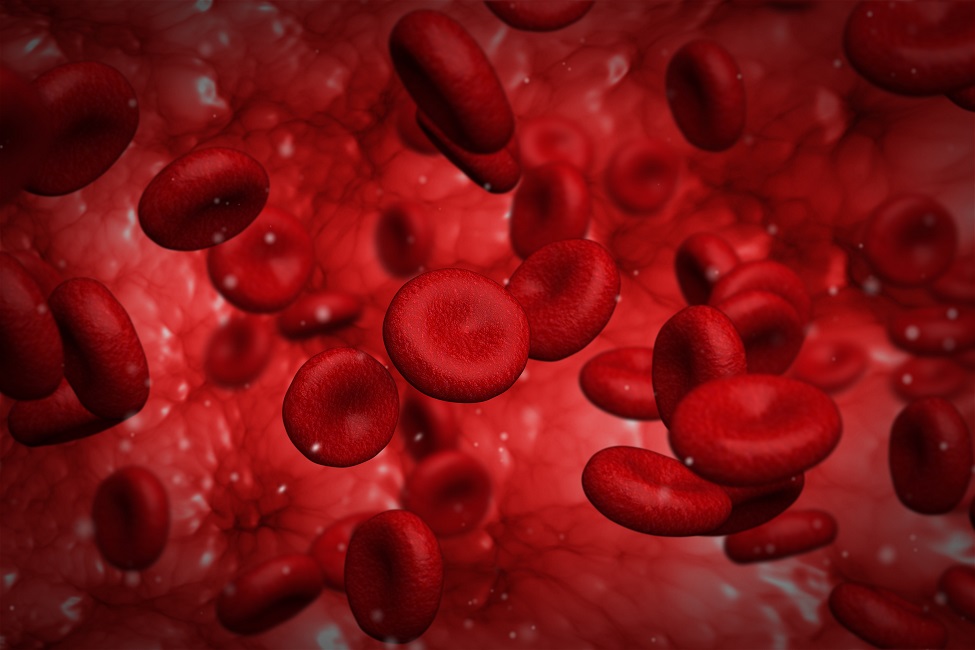Novel Assay Finds New Mechanism Underlying Red Blood Cell Aging

Red blood cells
Red blood cells are the most abundant cell type in blood, carrying oxygen throughout the human body. In blood circulation, they repetitively encounter various levels of oxygen tension. Hypoxia, a low oxygen tension condition, is a very common micro-environmental factor in physiological processes of blood circulation and various pathological processes such as cancer, chronic inflammation, heart attacks and stroke. In addition, an interplay between poor cellular deformability and impaired oxygen delivery is found in various pathological processes such as sickle cell disease. Sickle red blood cells simultaneously undergo drastic mechanical deformation during the sickling and unsickling process.
The interactions between hypoxia and cell biomechanics and the underlying biochemical mechanisms of the accelerated damage in diseased red blood cells are well understood, however, the exact biomechanical consequences of hypoxia contributing to red blood cell degradation (aging) remains elusive.
Researchers from Florida Atlantic University’s College of Engineering and Computer Science , in collaboration with the Massachusetts Institute of Technology (MIT), sought to identify the role of hypoxia on red blood cell aging via the biomechanical pathways. In particular, they examined hypoxia-induced impairment of red blood cell deformability at the single cell level, compared the differences between non-cyclic hypoxia and cyclic hypoxia, and documented any cumulative effect vs. hypoxia cycles, such as aspects that have not been studied quantitatively. Red blood cell deformability is an important biomarker of its functionality.
For the study, published in the journal Lab on a Chip , researchers developed a multifaceted microfluidic in vitro assay to precisely control the gaseous environment while probing the mechanical performance of red blood cells, which can be used as a characterization tool for other cell types involved in oxygen-dependent biological processes. The assay holds promise for investigating hypoxic effects on the metastatic potential and relevant drug resistance of cancer cells. Cancer cells are more metastatic in a hypoxic tumor microenvironment and cancer cell stiffness has been shown to be an effective biomarker of their metastatic potential.
Findings from the study indicate an important biophysical mechanism underlying red blood cell aging in which the cyclic hypoxia challenge alone can lead to mechanical degradation of the red blood cell membrane. This process in combination with the deformation-induced mechanical fatigue represents two major fatigue loading conditions that circulating red blood cells experience.
“A unique feature of our system lies in that the cell deformability measurement can be made on multiple, individually tracked red blood cells under a well-controlled oxygen tension environment,” said Sarah Du, Ph.D., senior author, an associate professor in FAU’s Department of Ocean and Mechanical Engineering, and a member of FAU’s Institute for Human Health and Disease Intervention (I-HEALTH). “Our results showed that the deformability of red blood cells decreases under deoxygenation conditions by before-and-after mechanical characterization of individual cells in response to the switching of oxygen levels within a microfluidic device.”
Microfluidics serves as a miniaturized and efficient platform for gas diffusion by interfacing the gas and aqueous solution through flow or a gas-permeable membrane, which also is amenable to the control of the cellular gaseous microenvironment.
For the study, researchers subjected red blood cells to a well-controlled repeated hypoxia microenvironment while allowing simultaneous characterization of the cell mechanical properties. They integrated an electro-deformation technique into a microdiffusion chamber, which was easy to implement and flexible in simultaneous applications of cyclic hypoxia challenge and shear stresses on individual cells in suspension and under quasi-stationary conditions.
Measurements of biomarkers, such as oxidative damage, can provide additional information to establish quantitative relationships between the fatigue loading and the biological processes, allowing a better understanding of red blood cell failure and aging. The microfluidic assay also can be extended to study other types of biological cells for their mechanical performance and response to gaseous environments.
“The unique method developed by professor Du’s lab also can be a useful tool to predict the mechanical performance of natural and artificial red blood cells for transfusion purposes as well as to assess the efficacy of relevant reagents in extending the cellular lifespan in circulation,” said Stella Batalama, Ph.D., dean, College of Engineering and Computer Science. “This promising and cutting-edge assay has the potential to further extend to red blood cells in other blood diseases and other cell types.”
Study co-authors are Ming Dao, Ph.D., Department of Materials Science and Engineering, MIT; Yuhao Qiang, Ph.D., FAU College of Engineering and Computer Science and currently a postdoctoral researcher at MIT; and Jia Liu, Ph.D., FAU College of Engineering and Computer Science.
This research is based on the materials supported by the National Science Foundation.
-FAU-
Latest Research
- 'Eye' on Health: AI Detects Dizziness and Balance Disorders RemotelyFAU researchers and collaborators have developed a cost-effective, AI-powered system for diagnosing nystagmus - a condition causing involuntary eye movements - using smartphone videos and cloud-based analysis.
- Study Explores Barriers and Trends in Cannabis Use Disorder TreatmentA study over a 16-year period by FAU researchers shows a troubling decline in treatment for cannabis use disorder and reveals why most people with the disorder don't seek help.
- Fixing the Leak: An Opioid Treatment for Dopamine Disorders?A breakthrough by FAU researchers shows that blocking the kappa opioid receptor improves behavioral deficits tied to ADHD, autism and bipolar disorder, providing a potentially safer yet effective treatment.
- FAU Data Analysis: Falling Rates Bring Some Relief to BanksFalling interest rates brought some relief to banks' portfolios for unrealized losses on investment securities, according to a data analysis from a finance professor at Florida Atlantic University.
- FAU Experts for the 2025 Atlantic Hurricane SeasonSeveral Florida Atlantic University faculty experts are available to discuss a range of hurricane-related topics such as preparedness, evacuation planning, storm impacts and post-disaster recovery.
- FAU Engineering Lands NSF Grant for Multi-robot Coordination TestbedThe project will tackle some of the most challenging problems in autonomous systems by enabling robust, scalable coordination of aerial robot teams in unpredictable real-world environments.






